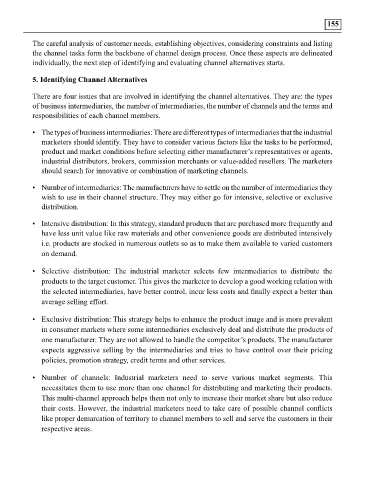Page 155 - Warehouse 1 to 9
P. 155
154 155
The careful analysis of customer needs, establishing objectives, considering constraints and listing
designer has to know at this stage itself that providing superior service output means increased the channel tasks form the backbone of channel design process. Once these aspects are delineated
channel costs and higher prices for customers. individually, the next step of identifying and evaluating channel alternatives starts.
2. Establishing Channel Objectives 5. Identifying Channel Alternatives
Channel objectives are a part of and result from the company’s marketing objectives that need to There are four issues that are involved in identifying the channel alternatives. They are: the types
be stated in terms of targeted service output levels. Profit considerations and asset utilization must of business intermediaries, the number of intermediaries, the number of channels and the terms and
be reflected in channel objectives and the resultant design. It should be the endeavor of the channel responsibilities of each channel members.
members to minimize the total channel costs and still provide with the desired level of service
outputs. Channel objectives keep varying depending on the characteristics of the products. For • The types of business intermediaries: There are different types of intermediaries that the industrial
example, while a customized non-standard product requires company sales force to sell directly, marketers should identify. They have to consider various factors like the tasks to be performed,
products like HVAC (Heating, Ventilation and Air-conditioning) are either sold by the company or product and market conditions before selecting either manufacturer’s representatives or agents,
its franchised dealers. industrial distributors, brokers, commission merchants or value-added resellers. The marketers
should search for innovative or combination of marketing channels.
3. Considering Channel Constraints
• Number of intermediaries: The manufacturers have to settle on the number of intermediaries they
The industrial marketer develops his channel objectives keeping into consideration various wish to use in their channel structure. They may either go for intensive, selective or exclusive
constraints like the company, competition, the environment, product characteristics and the level distribution.
of service output desired by the target customers.
• Intensive distribution: In this strategy, standard products that are purchased more frequently and
1. Company: If a company has financial limitation as constraint, then it may restrict its direct
distribution approach through company sales force to few high potential customers. have less unit value like raw materials and other convenience goods are distributed intensively
i.e. products are stocked in numerous outlets so as to make them available to varied customers
2. Competition: If a competitor has been very successful through direct service then it may force on demand.
all other firms also to adopt the same strategy of direct selling.
• Selective distribution: The industrial marketer selects few intermediaries to distribute the
3. Environment: Economic conditions, legal regulations are the environmental factors that affect products to the target customer. This gives the marketer to develop a good working relation with
channel design. During recession, producers use economical ways to sell the products to avoid
additional costs. Similarly, the law looks down upon those channel arrangements that tries to the selected intermediaries, have better control, incur less costs and finally expect a better than
build a monopoly market or minimize competition. average selling effort.
4. Product characteristics: As already mentioned, complex and non-standard products require direct • Exclusive distribution: This strategy helps to enhance the product image and is more prevalent
distribution without any intermediaries. Eg. If an industrial marketer is providing customized in consumer markets where some intermediaries exclusively deal and distribute the products of
machinery to his customer, then he deals directly with him rather than involving any intermediary one manufacturer. They are not allowed to handle the competitor’s products. The manufacturer
to understand the customer needs better. expects aggressive selling by the intermediaries and tries to have control over their pricing
policies, promotion strategy, credit terms and other services.
5. Customer: The industrial marketers depends on intermediaries to offer services to customers
who are either giving less business or are located at far-off places and prefers to serve the nearby • Number of channels: Industrial marketers need to serve various market segments. This
or high potential customers by themselves. necessitates them to use more than one channel for distributing and marketing their products.
This multi-channel approach helps them not only to increase their market share but also reduce
4. Listing Channel Tasks
their costs. However, the industrial marketers need to take care of possible channel conflicts
The industrial marketers have to creatively structure the necessary tasks or functions to meet like proper demarcation of territory to channel members to sell and serve the customers in their
customer requirements and company goals. They have to first make a list of various tasks to be respective areas.
performed, identify the critical tasks, take objective and realistic decisions on which tasks can be
effectively performed by the company and which cannot be performed due to certain constraints.

